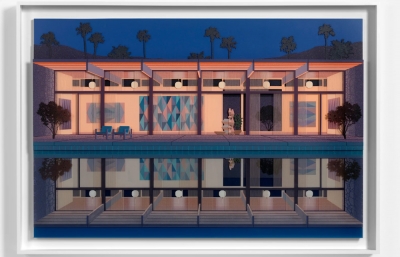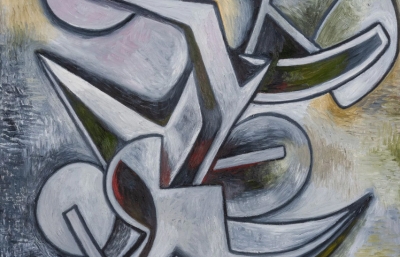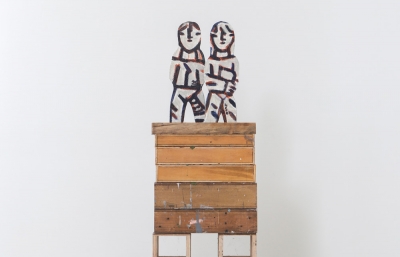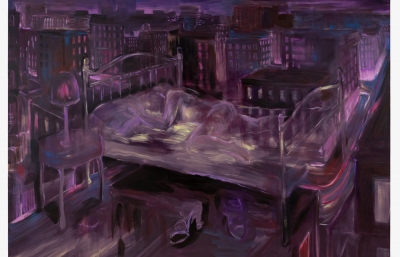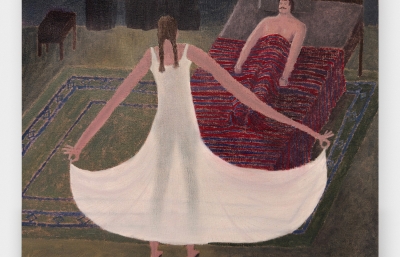Rebecca Ness
The Tools of Her Trade
Interview and portrait by Sasha Bogojev
In a panoply of patterns, textures, brushstrokes and marks done with an array of tools, Rebecca Ness renders the hyper vibrant world before her. Framed exactly the way she perceives them, seemingly unimportant moments in her daily commute and casual snapshots from everyday life are encapsulated in color. With a focus on non-verbal engagement, especially through clothing and attire as a source of communication, she comfortably explores the possibilities of painting while dipping into unconventional technique and concept.
Fresh out of Yale, with an MFA in Painting and Printmaking, and anchored with historical perspective, Ness freely experiments and plays with points of view, format and unique depiction. From extreme angles to oversaturated color, her unusual compositions are a painterly answer to the onslaught served daily on our screens. Imbued with subtle, clever metaphors, her vibrant images tell intimate stories of a young person navigating the current landscape.

Sasha Bogojev: Since you’ve just finished school, doors must be opening and a lot is changing in your professional life. How does it feel?
Rebecca Ness: I guess I'm thinking a lot about pacing right now, because in graduate school, you're expected to create a lot of things really quickly and just keep pushing out ideas at this really rapid pace. Right now, I'm slowing down a lot more and focusing on just a few ideas rather than the whole gamut, which I think is really fun and nice to do. I feel like I have some time now to breathe.
I really loved my grad school experience because I think the rapidness of working allowed me to work through ideas at a rate that I wouldn't otherwise. Before, I was in Boston and painting in my bedroom. I was working a nine-to-five and would come home, and then have to go to bed to go to work the next day. I would only get, like, four hours or so to work a day, five if I didn't want to sleep that much. So, the gift of grad school was, "This is the only thing you have to worry about, but you have to worry about it a lot,” which I liked. Now it's nice to kind of put everything back together again and figure out what I want to do, make my own schedule and my own demands, which is really nice.

Does it feel it's been more productive since you've been able to work that way?
I think so. Looking back at pre-grad school, I think I've definitely figured out my shit out a lot more. And grad school is really productive, too. I just think now I'm able to look back at all my notes and actually have time to think about those things and make a painting about it.
Are you done with formal education or is there something else you would like to pursue academically?
There are no more degrees that I want to get. I taught a few classes at Yale as a teaching assistant, mostly entry-level classes, which I really liked. We taught a bunch of non-art majors who, coming into the class, were really intimidated about art. I think one of my favorite things about teaching, and specifically at that entry-level, is taking away the scariness and showing that it's not really talent, but mostly a skill that you have to learn. Like drawing is a skill, and you can have a base talent for anything, but if you're not taught how to hone it, then it's not going to amount to anything.
It was really nice to have a lot of Economics majors and English majors who came in and they had this base level of talent and were really intimidated, but we stripped that away. We were like, "No, you just look at things this way or you use this technique." And I saw the intimidation kind of leave them, which I really liked. So, in terms of education, I can definitely see myself teaching those entry-level classes.

How much do you think your education shaped what you're making?
I was really excited to work with all my professors, and I wouldn't have expected my work to go this way, but am really glad that it did. When I first came into grad school, I was mostly making these really small gouaches on paper. I mainly applied with works that were eight-by-eight inches. They were small because that's all I could really make in my bedroom. In my undergrad education, I only really painted with oil, but went away from it because I didn't think it was serving the language I wanted to make. So, I never expected to go back to it, but when seeing my peers' work, and through conversations with professors in the studio, I realized that oil could actually aid and develop my language, and maybe some other things that I was using were restricting it.
You're officially back to oil now?
Yeah. I still make my small studies with gouache and I view that as very much its own separate thing. They're not really studies to me, they are paintings, just maybe in a slightly different world. They're like a different way to activate my brain.
What did you notice regarding oils and how did that influence your work?
The fluidity, obviously, is very different from gouache, which dries in, like, ten seconds, where this dries in ten days or so. That's also forced me to slow down in a sense. My production level is slightly less, but I think that the quality of the work is better because I'm forced to sit with this wet thing.

Definitely separate worlds. I'm such a sucker for oils myself, and I love these new works you're making.
It's just so yummy.
So, how did this residency happen?
It’s my first international residency. Nino Mier and I have been talking on and off for a few years. We started talking when I first entered Yale, or maybe even a little before, back in 2016. I've always been a really big fan of his program and the artists he represents. I'm a fan-girl of folks like Jansson Stegner and Celeste Dupuy-Spencer.
I love the work that he facilitates and the work that he shows. So, it's just been like this slow process of checking in every now and then. We were chatting about his and my plans a few months ago, and he mentioned that he wanted to make this residency program here in his empty apartment and wondered if I would be interested, so I was like, "Hell, yeah. Of course." When I traveled Europe during undergrad, Germany was my favorite country, and I always knew that I wanted to come back in some capacity, so this is like the perfect way to do it.
So many things are nicely coming together at the right time.
I feel really lucky that I am able to do all of these things right now, with painting as the reason for them. It's kind of a dream.

Did you notice new inspiration from being in a different place and environment?
I've been thinking about taking on some more real-world documentary influences in my work. I've always been a really big fan of Norman Rockwell, who had this weird mix of taking important, contemporary events, but still crafting the image in a personal way. He would bring in people from the neighborhood and dress them in a certain way, to play a character or pose, then take all this photographic documentation to create and build an image. I think that's what I'm interested in now because a lot of my work before was purely from my own internal experiences. They were "invented," but now there's a lot more of actually looking out into the world, taking pieces of it, and then crafting the image.
I make a lot of collages on my iPad, which is very important to how I make paintings. And definitely being here with everything so visually new, I'm not blind to anything, like if I was in New Haven or New York. I think we become blind to a lot of extremely cool experiences or visual phenomena in places that we're comfortable with, but here I'm just like a puppy, everything is shiny. So I'm like, "Let me take a photo of this and this and this and this," and craft a cool image. So, in that way, definitely.

I noticed that as long as I've been following your work, the subjects change quite a bit, from broken figures, to fabric patterns, to skin textures and sneakers. How do you see, feel, or explain those changes?
I think it's all kind of this exploration to figure out the perfect soup of all of the elements that I like. Like the elements of the invention, the elements of weird points of view, or like stretching a finger too far, or moments like that. I think I'm constantly trying to figure out a painting that has the perfect amount of all of those, like a weird alchemy, because I like paintings that feel like magic. I like paintings where you look in one part and it's completely different, or contradicts in a positive way another aspect of the painting. I think in order for that to happen, there has to be a lot of different ingredients. And so, thinking back to some of my older work, where maybe there was less variety in those ingredients, I'm trying to spice it up.
Yeah, like the cropping of the images or the point of view are definitely the things that I always liked about your work. How do you choose which part of the whole image to create in a painting?
That's a really good question, because I think a lot about the point of view, whether it’s a crumb on the table, or the point of view of being a dog or a kid. Going back to that being blind about visual phenomena thing, it’s that we look around at things we know, and then we take them for what they are. But I'm just taking them in as a five-foot-two girl, who has very specific experiences, I guess.

Which is why I can relate to your work…
Yeah, the five-foot-two life. But what if I was a foot shorter? Everything would change. Or what if I were five feet taller? Everything would change and my entire life would be different. Painting is a really interesting way to figure that out, or think about, or just fantasize about being somebody different for a second.
I read in another interview about how you paint fabric patterns. Can you maybe elaborate on that?
For the past two or three years, I've been painting a lot of clothing, and it started off by thinking about how we present ourselves to the world every day and how clothing is a way, contemporaneously and historically, to do that. Thinking about maybe hanky codes in the '70s and '80s for gay men and how they would communicate what they wanted by the color of the hanky or where it's placed, on the side, in the back pocket. Or the button-up, buttoned all the way up, has been this flagging for lesbians, as well. Clothing can be used in this way to nonverbally communicate to others that you see them or you're with them. And for people in these situations, if they said it out loud, it would be dangerous.
So, that was kind of the base interest of my idea. I started thinking about how this fits in with people every day, so I reached out to a lot of my friends or people that I don't even know, over Instagram and stuff, to send me photos of themselves and an item of clothing that they feel really identifies them or where they feel really comfortable. Or, my dream would be to paint the sweatshirt that someone wore on their first kiss or something like that. Now I'm making these paintings that show the whole closet too, kind of a whole dictionary of how we identify ourselves.

I like how you switched from the patterns, which I liked a lot, to these new skin textures. Tell me about these.
As a figurative painter, throughout my life, pretty consistently, I've always tried to think about how we paint skin in a way that does justice to it. While I was painting jeans, like denim jeans and fabric, I saw these ceramic tools and I thought maybe they would come in handy for making the weave of a jean. I was really obsessed with Barkley Hendricks at that time, and he made these beautiful denim paintings. So I was like, "Fuck, how do I do that?" Or, "Damn, how do I do that?"
I had them lying around, and tried them for the jeans, and they didn't quite work, but I was making a painting with these two giant hands, and I was painting them how I normally would with just wet into wet. Just using a brush. I had this idea of using the ceramic tool to make the finger elbow, the finger wenis thing, this little fold on each of our knuckles.
And the rest is history, I guess?
I tried that, and then I tried it more on the rest of the hand. And it gave this hand a kind of vibrant, kind of living, throbbing feeling, and that's what I think I had always been searching for in making skin. How do I make it actually move and grow like skin does and feel more organic? I stuck with that for a while, but I'm continuously looking for new tools. I've been working a lot with Q-tips as well. But just continuously thinking about how to use different tools to my advantage.
In my last semester at Yale, we had Mickalene Thomas as our mentor. Continuously throughout the three studio visits that I had with her, tools were the conversation over and over again. It's like, we have all of these tools around us, but we're blind. We are these tradespeople, in a way, who have the opportunity to use all of these things around us. That was like a big investigation for me last semester, and I came out using Q-tips and ceramic tools.

Do you remember the moment when your perspective shifted from your own personal life to opening your eyes towards others? Did that result in painting images in a more realistic way?
The moment I realized that maybe my work could project a little bit more outwards was while I was on the Metro-North, which is the train that goes to New Haven to New York and back. I was opposite this sort of older guy who was reading the New York Times with this giant photo of Trump making some military speech or whatever. It was April 19th, 2019, and in this giant photo of Trump, he was speaking out, basically to me, and there were all of these military, mostly white military guys, staring back at me too, with these giant smiles.
It sounds like a nightmare…
It was really creepy and odd, and it was this moment of the outward coming to the inward, like this kind of connection. This guy who I don't even know just randomly flipped to this page and I had this connection with him and the world, and I started looking at him and maybe trying to figure out who he was, analyzing how he was dressed. I've always really liked thinking about sartorial things, like I paint shoes, I painted closets in my past pattern work; I've always been thinking about how we present ourselves to the world.
I guess, at this moment and in this painting that I'm working on, it was just that immediate connection. I think now I'm just primed and trying to find those moments of connection more, like out in the world of things that we can connect with.

What was the earliest feedback you got about the sneakers or the skin pictures?
I've been getting a lot of feedback on the skin, which I'm happy about. I think that has been my biggest thing and my... I don't like the word “breakthrough,” because that sounds egotistical, but maybe something like my biggest discovery. Let's say I'm happy with painting discovery, and I think that has opened me up to think about how I can now discover a new way to paint everything else that I've been painting.
I think very much in terms of researching how to paint too; that's why I go and look at how other people paint, because you just take stuff from them. Like Barkley Hendricks—no one can paint like Barkley Hendricks and they never will, but I can look at how he painted the denim and be, like, "Maybe I can try to do like 1% of that."
Being here in Germany, do you have more international projects, shows, plans or something you want to reveal now?
I don't have anything planned internationally right now. I have a solo show at 1969 Gallery in New York and a solo show with Nino Mier in 2020. I’m thinking about pacing, as in, how do I make my best work at the best possible pace?
Yeah, that's how we started the conversation.
Yep, just painting. For now.


